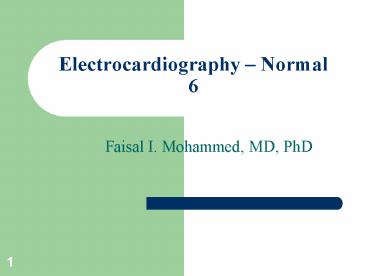Electrocardiography - PowerPoint PPT Presentation
Title:
Electrocardiography
Description:
The axis of lead III is 120 degrees. Principles of Vectorial Analysis of EKG s (cont d) * Principles of Vectorial Analysis of EKG s (cont d) In figure B, ... – PowerPoint PPT presentation
Number of Views:144
Avg rating:3.0/5.0
Title: Electrocardiography
1
Electrocardiography Normal6
- Faisal I. Mohammed, MD, PhD
2
Objectives
- Recognize the normal ECG tracing
- Calculate the heart rate
- Determine the rhythm
- Calculate the length of intervals and determine
the segments deflections - Draw the Hexagonal axis of the ECG
- Find the mean electrical axis of QRS (Ventricular
depolarization)
3
Principles of Vectorial Analysis of EKGs
- The current in the heart flows from the area of
depolarization to the polarized areas, and the
electrical potential generated can be represented
by a vector, with the arrowhead pointing in the
positive direction. - The length of the vector is proportional to the
voltage of the potential. - The generated potential at any instance can be
represented by an instantaneous mean vector. - The normal mean QRS vector is 60o (-30? - 110?)
4
Mean Vector Through the Partially Depolarized
Heart
_
_
_
_
_
_
_
_
_
_
_
_
_
_
_
_
_
_
_
_
_
_
_
_
_
_
_
_
_
_
_
_
_
_
_
_
_
_
_
_
_
_
5
Einthovens triangle and law
?
?
?
6
(No Transcript)
7
Principles of Vectorial Analysis of EKGs (contd)
8
Axes of the Unipolar Limb Leads
I
aVL
aVR
-
aVF
9
Principles of Vectorial Analysis of EKGs (contd)
- The axis of lead I is zero degrees because the
electrodes lie in the horizontal direction on
each of the arms. - The axis of lead II is 60 degrees because the
right arm connects to the torso in the top
right corner, and left leg connects to the
torso in the bottom left corner. - The axis of lead III is 120 degrees.
10
Principles of Vectorial Analysis of EKGs (contd)
11
Principles of Vectorial Analysis of EKGs (contd)
- In figure B, the depolarization vector is large
because half of the ventricle is depolarized. - Lead II should be largest voltage when compared
to I and III when the mean vector is 60o. - In figure C, left side is slower to depolarize.
- In figure D, the last part to depolarize is near
the left base of the heart which gives a negative
vector (S wave). - Q wave is present if the left side of the septum
depolarizes first.
12
The T Wave (Ventricular Repolarization)
- First area to repolarize is near the apex of the
heart. - Last areas, in general, to depolarize are the
first to repolarize. - Repolarized areas will have a charge first
therefore, a net vector occurs and a positive T
wave
13
Atrial Depolarization (P-Wave) and Atrial
Repolarization (Atrial T Wave)
- Atrial depolarization begins at sinus node and
spreads toward A-V node. - This should give a vector in leads I, II, and
III. - Atrial repolarization cant be seen because it is
masked by QRS complex. - Atrial depolarization is slower than in
ventricles, so first area to depolarize is also
the first to repolarize. This gives a negative
atrial repolarization wave in leads I, II, and III
14
Vectorcardiogram
- This traces vectors throughout cardiac
cycle. - When half of the ventricle is depolarized,
vector is largest.
- Note zero reference point, number 5, is point of
full depolarization.
15
Plot of the Mean Electrical Axis of the Heart
from Two Electrocardiographic Leads
III
_
-60o
I
_
I
I
II
0o
180o
III
60o
120o
III
16
(No Transcript)
17
(No Transcript)
18
aVF ?
SEVERE RIGHT OR LEFT AXIS DEVIATION OF
QRS From 180 to 360 (-90)
?90?
LEFT AXIS DEVIATION OF QRS
Lead I ?
Lead I
180?
0?
NORMAL MEAN ELECTRICAL AXIS OF QRS From 0 to 90
RIGHT AXIS DEVIATION OF QRS From 90 to 180
90?
aVF
19
Heart Rate Calculation
- R-R interval 0.83 sec
- Heart rate (60 sec)/(0.83 sec) 72 beats/min
min beat
20
ECG Calculations
21
ECG Calculations
22
Determine regularity
R
R
- Look at the R-R distances (using a caliper or
markings on a pen or paper). - Regular (are they equidistant apart)?
Occasionally irregular? Regularly irregular?
Irregularly irregular? Interpretation?
Regular
23
ECG Deflection Waves
Atrial repolarization
(Pacemaker)
24
ECG Deflection Waves
60 seconds 0.8 seconds resting heart rate of
75 beats/minute
1st Degree Heart Block P-Q interval longer than
0.2 seconds.
25
ECG Deflection Wave Irregularities
Enlarged QRS
Hypertrophy of ventricles
26
ECG Deflection Wave Irregularities
Prolonged QT Interval
Repolarization abnormalities increase chances of
ventricular arrhythmias.
27
ECG Deflection Wave Irregularities
Elevated T wave
Hyperkalemia
28
ECG Deflection Wave Irregularities
Flat T wave
Hypokalemia or ischemia
29
Thank You































